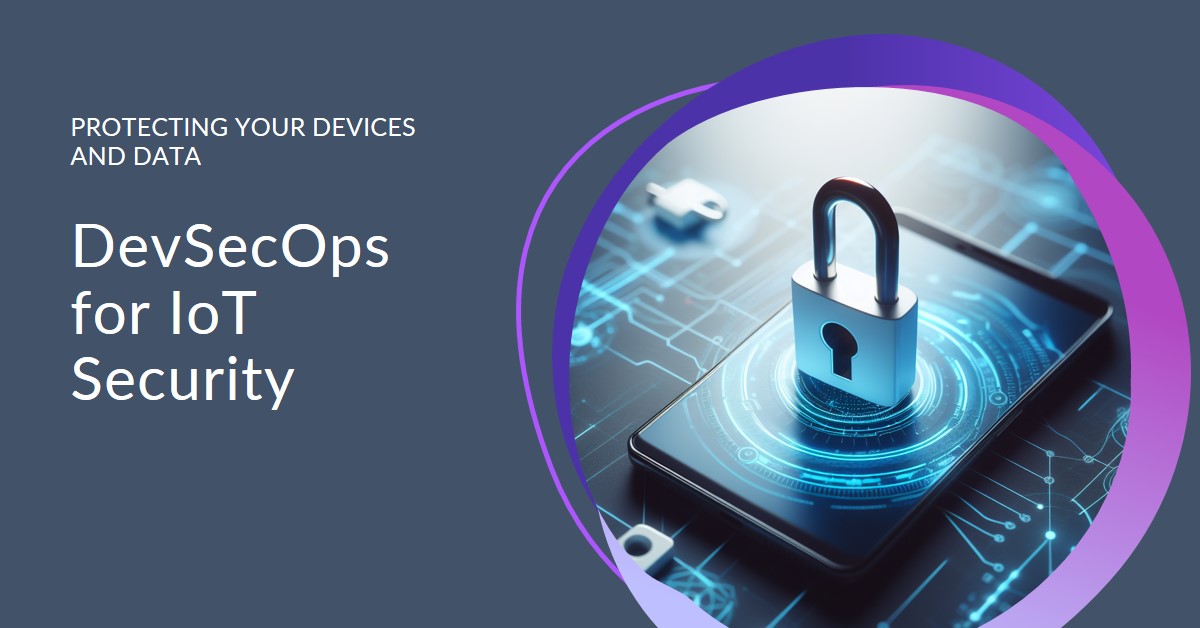The rapid proliferation of Internet of Things (IoT) devices has revolutionized the way we interact with the world around us. From smart homes and wearables to industrial sensors and autonomous vehicles, IoT technology has become an integral part of our daily lives. However, this surge in connectivity also brings forth unprecedented challenges, particularly in terms of security. DevSecOps, an extension of the DevOps methodology, emerges as a crucial framework to address these security concerns in the realm of IoT. In this comprehensive guide, we will explore the landscape of IoT security and delve into the principles, practices, and benefits of implementing DevSecOps in the context of securing IoT ecosystems.
A Comprehensive Guide to DevSecOps for IoT Security

Before delving into the specifics of DevSecOps, it’s essential to grasp the unique challenges that IoT security presents. Unlike traditional software applications, IoT devices are characterized by their distributed nature, diverse communication protocols, and constrained resources. The sheer scale and heterogeneity of IoT ecosystems make them susceptible to a wide array of security threats. Common challenges in IoT security include:
- Device Vulnerabilities: Many IoT devices lack robust security measures, making them vulnerable to attacks such as malware injection, unauthorized access, and device tampering.
- Data Privacy Concerns: The vast amounts of data generated by IoT devices, often sensitive in nature, raise concerns about data privacy and the potential misuse of personal information.
- Network Security: IoT devices communicate over various networks, and insecure communication protocols can expose them to eavesdropping, man-in-the-middle attacks, and other network-based threats.
- Authentication and Access Control: Weak authentication mechanisms and inadequate access controls can lead to unauthorized access, potentially compromising the entire IoT ecosystem.
- Firmware and Software Vulnerabilities: Outdated or insecure firmware and software on IoT devices can serve as entry points for attackers to exploit vulnerabilities.
Introducing DevSecOps
DevSecOps is an evolution of the DevOps methodology, integrating security practices seamlessly into the software development and deployment lifecycle. The primary goal of DevSecOps is to instill a security-first mindset across development, operations, and security teams, fostering collaboration and continuous improvement. In the context of IoT security, implementing DevSecOps ensures that security measures are not an afterthought but an integral part of the entire IoT lifecycle.
The DevSecOps Lifecycle for IoT Security
1. Planning and Design Phase:
- Threat Modeling: Identify potential security threats and vulnerabilities specific to the IoT ecosystem.
- Security Requirements: Define security requirements at the outset, ensuring they are integrated into the design of IoT devices and systems.
2. Development Phase:
- Code Analysis: Implement static and dynamic code analysis tools to identify and rectify security vulnerabilities in the codebase.
- Secure Coding Practices: Enforce secure coding standards and practices to mitigate common IoT security risks.
3. Testing Phase:
- Automated Security Testing: Integrate automated security testing, including penetration testing and vulnerability scanning, into the continuous integration/continuous deployment (CI/CD) pipeline.
- Fuzz Testing: Conduct fuzz testing to identify and address potential input validation issues.
4. Deployment Phase:
- Immutable Infrastructure: Embrace the concept of immutable infrastructure, where deployment artifacts are consistently reproducible, reducing the risk of configuration drift and ensuring a known and secure state.
5. Operation and Monitoring Phase:
- Continuous Monitoring: Implement continuous monitoring for IoT devices and networks, detecting and responding to security incidents in real-time.
- Incident Response Planning: Develop and regularly update incident response plans to minimize the impact of security breaches.
6. Feedback and Improvement Phase:
- Post-Incident Analysis: Conduct thorough post-incident analyses to understand the root causes of security incidents and implement corrective actions.
- Security Training: Provide ongoing security training for development, operations, and security teams to stay abreast of evolving threats and best practices.
Benefits of Implementing DevSecOps in IoT Security
- Early Detection and Mitigation of Vulnerabilities:
- By integrating security measures throughout the development lifecycle, vulnerabilities are identified and addressed early, reducing the attack surface for potential threats.
- Collaborative Approach:
- DevSecOps fosters collaboration between development, operations, and security teams, breaking down silos and ensuring a unified approach to security.
- Automation for Efficiency:
- Automation of security testing and compliance checks in the CI/CD pipeline streamlines processes, enabling faster and more reliable delivery of secure IoT applications.
- Continuous Monitoring and Adaptation:
- Continuous monitoring allows for real-time threat detection and response, and the feedback loop ensures that security measures are continually adapted to evolving threats.
- Regulatory Compliance:
- DevSecOps practices facilitate adherence to regulatory requirements, helping organizations navigate the complex landscape of IoT security compliance.
- Improved Incident Response:
- With well-defined incident response plans and continuous monitoring, organizations can respond promptly to security incidents, minimizing potential damage.
Real-world Examples of DevSecOps in IoT Security
- Smart Home Security:
- DevSecOps practices can be applied to secure smart home devices, ensuring that vulnerabilities are addressed during the development phase and that continuous monitoring safeguards against emerging threats.
- Industrial IoT (IIoT):
- In industrial settings, implementing DevSecOps can enhance the security of IIoT devices and systems, protecting critical infrastructure from cyber threats and ensuring the reliability of operations.
- Healthcare IoT:
- The healthcare sector relies on IoT devices for patient monitoring and data collection. DevSecOps helps mitigate security risks in medical devices, safeguarding sensitive patient information.
Challenges and Considerations
- Resource Constraints:
- IoT devices often have limited resources, presenting a challenge in implementing robust security measures without compromising performance.
- Diverse Ecosystems:
- The heterogeneity of IoT ecosystems requires tailored security approaches for different devices and industries, adding complexity to the implementation of DevSecOps.
- Legacy Systems:
- Many IoT deployments involve legacy systems that may not be easily compatible with modern DevSecOps practices. Organizations need strategies to secure both new and existing IoT infrastructure.
Future Trends and Innovations
- AI and Machine Learning in IoT Security:
- Integration of AI and machine learning technologies into IoT security solutions for anomaly detection, behavior analysis, and threat prediction will play a significant role in enhancing the effectiveness of DevSecOps practices.
- Blockchain for IoT Security:
- The use of blockchain technology can enhance the integrity and security of data exchanged between IoT devices. Implementing decentralized and tamper-resistant ledgers can contribute to the overall security posture of IoT ecosystems.
- Edge Computing Security:
- As edge computing becomes more prevalent in IoT deployments, securing edge devices and ensuring the integrity of data processing at the edge will become critical. DevSecOps practices will need to adapt to address the unique challenges posed by edge computing.
- Standardization and Certification:
- The development of industry-wide standards and certifications for IoT security will provide a framework for organizations to ensure their DevSecOps practices align with recognized best practices and requirements.
Conclusion
Securing the vast and complex landscape of IoT requires a proactive and integrated approach to cybersecurity. DevSecOps, with its emphasis on collaboration, automation, and continuous improvement, proves to be a potent framework for addressing the unique challenges posed by IoT security. By incorporating security practices throughout the entire lifecycle of IoT development, organizations can build resilient and secure IoT ecosystems that safeguard both users and critical infrastructure. As we continue to witness the evolution of IoT and the cybersecurity landscape, the adoption of DevSecOps principles will be instrumental in ensuring a secure and connected future.
FAQs: Demystifying DevSecOps for IoT Security
Q1: What is DevSecOps, and how does it differ from traditional security approaches?
A1: DevSecOps is an extension of the DevOps methodology that integrates security practices into every phase of the software development lifecycle. Unlike traditional security, which is often treated as a separate phase, DevSecOps promotes a continuous and collaborative approach, ensuring that security is ingrained from the planning to the deployment phase.
Q2: Why is DevSecOps particularly crucial for IoT security?
A2: IoT security presents unique challenges due to the distributed nature and diverse communication protocols of IoT devices. DevSecOps ensures that security measures are not an afterthought but an integral part of the entire IoT lifecycle, addressing vulnerabilities early and continuously adapting to emerging threats.
Q3: How does DevSecOps handle the resource constraints of IoT devices?
A3: DevSecOps acknowledges the resource constraints of many IoT devices and focuses on lightweight security measures that do not compromise performance. The use of automated security testing tools and efficient coding practices helps address security concerns without overburdening resource-limited devices.
Q4: Can DevSecOps be applied to existing IoT deployments with legacy systems?
A4: Yes, DevSecOps practices can be adapted for existing IoT deployments with legacy systems. While it may require some modifications and integration efforts, organizations can implement DevSecOps gradually, securing both new and existing IoT infrastructure over time.
Q5: How does DevSecOps contribute to regulatory compliance in IoT security?
A5: DevSecOps practices contribute to regulatory compliance by incorporating security requirements and standards into the development process. Continuous monitoring and automated testing help organizations demonstrate adherence to regulatory requirements, making it easier to navigate the complex landscape of IoT security compliance.
Q6: Can DevSecOps be applied to diverse IoT ecosystems, such as smart homes and industrial IoT?
A6: Yes, DevSecOps is adaptable to diverse IoT ecosystems. Its principles can be tailored to address the specific security challenges of different industries, including smart homes, industrial IoT, healthcare, and more. The key lies in understanding the unique requirements and threats associated with each ecosystem.
Q7: How does DevSecOps enhance incident response in IoT security?
A7: DevSecOps enhances incident response by promoting continuous monitoring and real-time threat detection. With well-defined incident response plans and ongoing security training, organizations can respond promptly to security incidents, minimizing potential damage and improving the overall resilience of IoT ecosystems.
Q8: What role does AI and machine learning play in DevSecOps for IoT security?
A8: AI and machine learning technologies play a significant role in enhancing the effectiveness of DevSecOps practices for IoT security. They can be used for anomaly detection, behavior analysis, and threat prediction, providing organizations with advanced capabilities to identify and respond to emerging security threats in real-time.
Q9: Are there industry-wide standards for implementing DevSecOps in IoT security?
A9: While there may not be specific industry-wide standards for DevSecOps in IoT security, there are general cybersecurity standards and frameworks that organizations can adhere to, such as ISO/IEC 27001 and NIST Cybersecurity Framework. Additionally, ongoing efforts are being made to develop specific standards and certifications for IoT security.
Q10: How can organizations get started with implementing DevSecOps for IoT security?
A10: Organizations can start by conducting a thorough assessment of their IoT security needs, implementing security requirements from the planning phase, and gradually integrating DevSecOps practices into their development and deployment processes. Collaborating across development, operations, and security teams is essential for a successful DevSecOps implementation.
See Also:
Empower Your Development: Top 5 DevSecOps Tools for Securing Software Excellence




